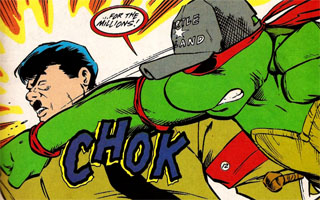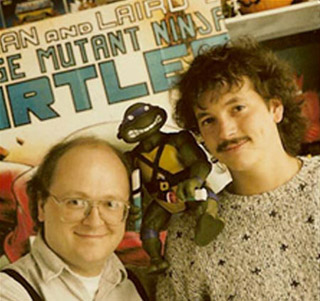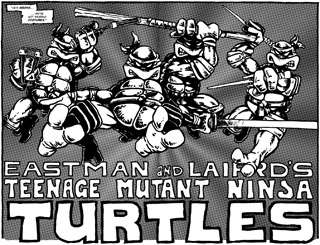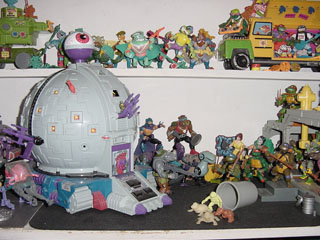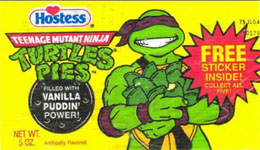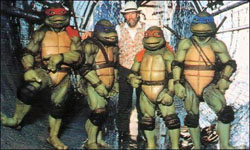
|
<<< Prior Page |
|
Page 1: |
Page 2: |
Page 3: |
Page 4: |
Page 5: |
|
Page 6: |
Page 7: |
Page 8: |
Page 9: |
Page 10: |
|
Page 11: |
Page 12: |
Page 13: |
Page 14: |
|
In the early 1980s, the young and eager duo of Peter Laird and Kevin Eastman created a true underground sensation in the comic book world with their creation of the Teenage Mutant Ninja Turtles. The bronze age of comic books had brought with it a much darker view, not only of the world we inhabit, but also the heroes themselves, which showcased more humanity and faded lines of heroism and psychological instability. The image of the hero was gradually changing not only internally, but also in visual display as the characters became more eccentric and flamboyant by each new title that hit the shelves monthly.
Teenage Mutant Ninja Turtles served to parody the direction that comic books had taken, but not by ridicule or overt humor. Rather TMNT played itself straight, blending the supernatural, folklore and mystique together with teenage angst, family bonds and honor in a fantastic dark drama of bloodshed and martial arts. Each of the four brothers had strong personalities which never winked at the reader, and audiences who were now themselves in their early teens and upwards could relate to the emotions of four ninja turtles growing up with them. The comic book released in 1984 became one of the most popular comic books of the year, and Eastman and Laird's studio Mirage had trouble keeping up with the print demand.
The late '70s and early '80s had also brought with it a new method of marketing towards kids' toy market. Entertainment properties were brought in from Japan or made within US soil. These properties were often action figure lines with extensive design work done to their presentation and given cartoon specials on Saturday morning television, giving children a familiarity with the characters on TV which hopefully would translate into profitability when they would see those same characters on display at their local toy store. He-Man, Transformers, Thundercats and GI Joe all benefited from their popular combination of toys and television which defined the 1980s toy market.
Eastman and Laird were also eager to capitalize on the fame that their little comic book had garnered, and sought out toy manufacturers all over the country. They would finally find interest in the then small sized Playmates company, who in turn brought in the highly acclaimed animator Fred Wolf. The once dark mutants suddenly became pizza loving dudesters, equally efficient in one liners and non sequiturs as they were with the art of Ninjitsu. The original comic book characters had all red headbands and in the black and white comics were differentiated through dialogue and carried weapon, but with Playmates and Wolf, they were given brightly colored headbands going along with their simplified personalities, and a larger cast of new mutants were created by Eastman and Laird that suited the action figure styling. The result of this redesign came with a toyline of the central cast and a 5 episode mini-series, which aired on December 28th, 1987. The series was not an overnight success, struggling to find its audience for nearly a year of re-runs but after the third re-broadcast, kids took notice and for years to come the TMNT brand would be one of the most powerful in the world, and confuse millions of children as to why Michelangelo sculpted a statue of a naked man.
For several years to come, TMNT could be found on virtually every piece of merchandise that could reasonably be sold to consumers, and the popularity expanded to every single corner of the world. It was not only in merchandising, but also in entertainment that the Ninja Turtles would see extensive experimental developments and interpretations with the franchise expanding to several versions and birthing an ever growing cast and radical redesigns. Over time there has been over 10 different universes of TMNT from the original comic books to the 1987 cartoon, live action movies, Japanese anime and the Adventures comic book. TMNT Adventures was published by Archie, and would prove to be one of the most inspirational tools for the video game series with its very alive and interesting cast of characters and strange storylines. Adventures managed to find a way for Raphael to punch Adolf Hitler in the face.
Gott im schildkroten!
The video game series of TMNT would be especially important, not only to its own brand, but also the development of licensed properties in video games. Picked up by Konami in late 1987, it would from there be known for its high quality, authentic feel and incredible multiplayer, and also be vital to the introduction of the beat-em-up genre to the console market, which by 1990 had been mostly dominated by Technos Corp's Double Dragon and Kunio series, as well as some mediocre efforts from other companies. With the TMNT line of games, two player gaming was redefined, and other developers had to take note of how to successfully integrate music, characters and stories that would interest the established fan base and bring in new fans as well. In Japan, TMNT was introduced into the country mainly through the 1989 arcade game, which enabled Ninja Turtles to be aired prime time on NHK two and later on TV Tokyo, a feat almost unheard of for an American produced cartoon show brought over to Japan. Over the 20 years that the four turtles have enjoyed their incredible fame and also tumultuous times, 30 games have been produced from Konami and later Ubisoft, ranging from all time classics, to all time lows.
Throughout those 30 games, the focus would mostly be on four different TMNT universes;
TMNT 1987 cartoon
TMNT Adventures comic books
TMNT 2k3 and TMNT 2007 cartoon and movie.
|
<<< Prior Page |
|
Page 1: |
Page 2: |
Page 3: |
Page 4: |
Page 5: |
|
Page 6: |
Page 7: |
Page 8: |
Page 9: |
Page 10: |
|
Page 11: |
Page 12: |
Page 13: |
Page 14: |
|
